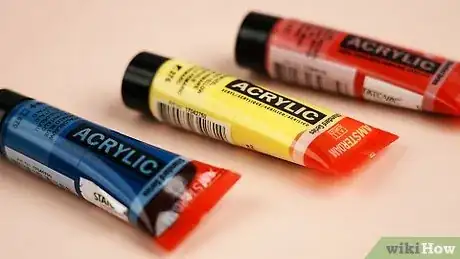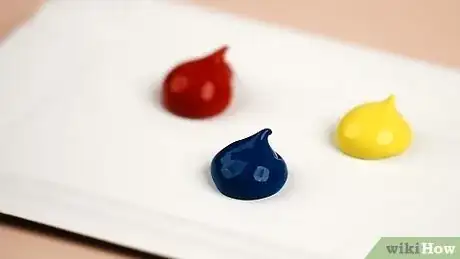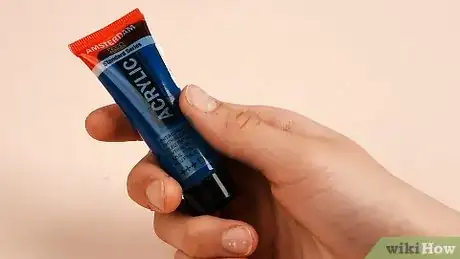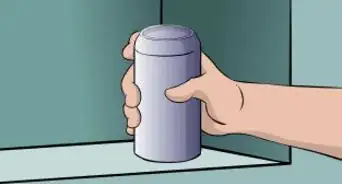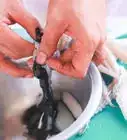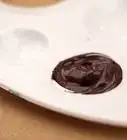This article was co-authored by Jeanine Hattas Wilson and by wikiHow staff writer, Kyle Hall. Jeanine Hattas Wilson is a Professional Painter and the President of Hattas Public Murals, Inc. With nearly 20 years of experience, Jeanine specializes in creating, overseeing, designing, and painting murals. Jeanine holds a BA in Advertising from Marquette University and a Studio Painting Minor from The Milwaukee Institute of Art & Design. She has studied at The Atelier Artien in Paris, France, Los Angeles Academy of Figurative Art, and under renowned artists such as Robert Liberace, Michael Siegel, and William Cochran. To date, Hattas Public Murals has painted nearly 5,000 commissioned works of art in homes and commercial and public spaces.
There are 8 references cited in this article, which can be found at the bottom of the page.
This article has been viewed 1,297,386 times.
Whether you’re painting the night sky, a dark shadow cast across a surface, or your portrait subject’s pupils, sometimes you just need black paint. But what if you don’t have any? Fortunately, black paint is super easy to make using other paint colors, and there are many different ways to do it. To help you get back to painting ASAP, we’ve rounded up the best ways to mix black paint using primary colors, complementary colors, and more. Time to get mixing!
Things You Should Know
- Mix equal parts red, blue, and yellow paint to make black.
- Alternatively, mix complementary colors to get black, like red and green, blue and orange, or purple and yellow.
- You can also make black by mixing blue and brown paint.
- If your paint ends up more brown than black, add more blue, preferably dark blue if you have it.
Steps
Using Primary Colors
-
1Grab red, blue, and yellow paint. You can actually make black using just the primary colors (red, blue, and yellow).[1] This will work with all types of paint, whether you're oil painting, watercoloring, or acrylic painting.
- If you’re using a nice set of paints with different shades of each color, try mixing Aureolin Yellow, Rose Madder Genuine, and Cobalt Blue to get a soft black. Alternatively, mix Winsor Yellow, Permanent Alizarin Crimson, and Winsor Blue to create a bold black. Really any shade of red, blue, and yellow will work though.
-
2Put equal amounts of each color on a palette. It works best to put the colors on the palette one at a time before you mix them. For a basic black, equal amounts of each color is a great place to start.[2]
- Using slightly more of one or two of the colors will give you a different shade of black. Don’t be afraid to play around with the colors!
- If you use a paintbrush to dab paint onto the palette, use a different brush for each color so you don't mix the paints except on the palette.
Advertisement -
3Mix the paints together. You can use a paintbrush or palette knife to mix the colors together. Keep mixing until all of the colors are evenly blended.
- Pro tip: if you use a paintbrush to mix the paint, swirl the brush gently and don't press down too hard. You can ruin brushes by pushing them too hard against the palette.
-
4Adjust the value and hue of the black. Value is how dark or light a color is, while hue is the level of red, blue, or yellow a color has in it.[3] For example, you might add a small dab of white paint to lighten the black (aka give it a lighter value), or you might add a drop more blue to give the black a blue hue (like if you’re painting a night sky).[4] [5]
- If you have time and paint to spare, experiment with the color. Add a little brown or green to the black to paint pine trees at night, or add some yellow for the sun reflecting off of black metal.
- Mixing paint by hand usually won't give you an exact black, but your black will have more character than pure black.
Using Complementary Colors
-
1Combine red and green paint. Mixing complementary paint colors, or colors that are opposite each other on the color wheel, actually cancels out the color properties of each and creates a dark, almost black color. You can choose any red or green paint, but Phthalo Green and Naphthol Red in particular work really well![6]
-
2
-
3Mix purple and yellow paint. Use about 60% purple and 40% yellow. Adjust the ratio as needed to get the black you’re looking for (adding more purple will give you a darker black). Cadmium Yellow mixed with violet works especially well, if you have them!
Using Blue and Brown
-
1Add blue paint, like Ultramarine Blue, to your palette. The blue will make up half of the total paint you’ll use, so add about half as much paint as you think you’ll end up needing to mix.[8]
-
2Add brown paint, like Burnt Umber, and mix the colors together. Adjust with a little more of either color until you get a black you like.
-
3Mix in a dab of dark blue paint, like Prussian Blue, for a darker black. A little dark blue paint works great for making a black that’s deep, dark, and striking.
Community Q&A
-
QuestionHow do you make black with colored pencils?
 wikiHow Staff EditorThis answer was written by one of our trained team of researchers who validated it for accuracy and comprehensiveness.
wikiHow Staff EditorThis answer was written by one of our trained team of researchers who validated it for accuracy and comprehensiveness.
Staff Answer wikiHow Staff EditorStaff AnswerTry layering dark blue colored pencil over dark brown to make black. Add more dark brown for a warmer black, or add more dark blue for a cooler black.
wikiHow Staff EditorStaff AnswerTry layering dark blue colored pencil over dark brown to make black. Add more dark brown for a warmer black, or add more dark blue for a cooler black. -
QuestionWhen I mix red, blue, and yellow, I get brown. What do I do?
 wikiHow Staff EditorThis answer was written by one of our trained team of researchers who validated it for accuracy and comprehensiveness.
wikiHow Staff EditorThis answer was written by one of our trained team of researchers who validated it for accuracy and comprehensiveness.
Staff Answer wikiHow Staff EditorStaff AnswerTry adding more blue to the mixture. You won't be able to get 100% pure black by mixing the primary colors, but you can still get something close enough! It will look black once you use it in your painting.
wikiHow Staff EditorStaff AnswerTry adding more blue to the mixture. You won't be able to get 100% pure black by mixing the primary colors, but you can still get something close enough! It will look black once you use it in your painting. -
QuestionWhat colors can I mix to make brown?
 Community AnswerYou can mix orange and purple to make a pretty solid brown.
Community AnswerYou can mix orange and purple to make a pretty solid brown.
Things You'll Need
Using Primary Colors
- Red paint
- Blue paint
- Yellow paint
Using Complementary Colors
- Red and green paint (option 1)
- Blue and orange paint (option 2)
- Purple and yellow paint (option 3)
Using Blue and Brown
- Blue paint
- Brown paint
- Dark blue paint (optional)
References
- ↑ Jeanine Hattas Wilson. Professional Painter. Expert Interview. 5 May 2021.
- ↑ https://www.webexhibits.org/causesofcolor/1BA.html
- ↑ http://char.txa.cornell.edu/language/ELEMENT/COLOR/color.htm
- ↑ http://emptyeasel.com/2006/12/22/how-to-make-better-oil-paintings-tips-and-techniques-for-correctly-mixing-color/
- ↑ Jeanine Hattas Wilson. Professional Painter. Expert Interview. 5 May 2021.
- ↑ https://www.goldenpaints.com/technicalinfo_mixguide
- ↑ https://www.color-meanings.com/what-colors-make-black/
- ↑ http://willkempartschool.com/the-3-myths-of-black-in-mixing-paint-colours/
- ↑ https://www.foodnetwork.com/holidays-and-parties/packages/halloween/how-to-make-black-food-coloring
About This Article
You can make black paint by mixing together equal parts red, blue, and yellow paint. You can also mix opposite colors on the color wheel to make black, like red and green, blue and orange, or yellow and purple. Blue and brown mixed together will also make black. For more tips, like how to adjust the value and hue of your black paint, keep reading!
